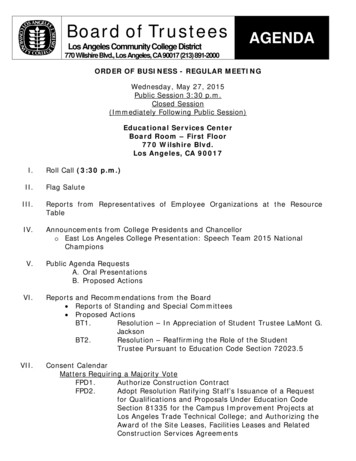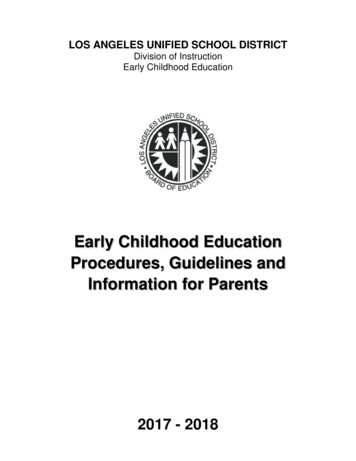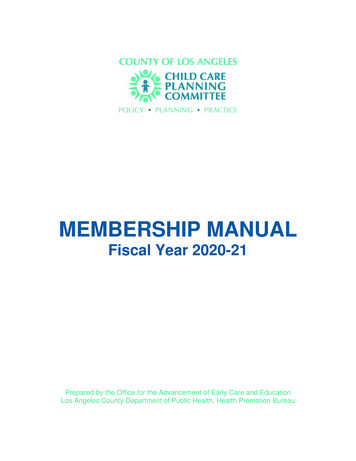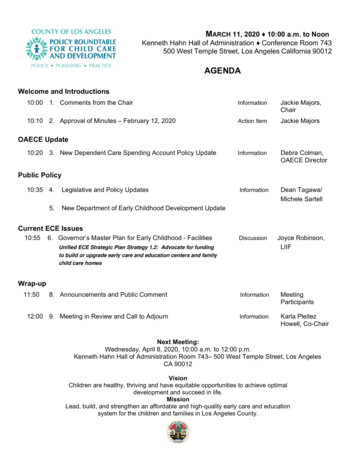
Transcription
COUNTY OF LOS ANGELESINSURANCE MANUALFORSERVICE AGREEMENTSRevised: 6HSWember 201 Chief Executive Office – Risk Management Branch(213) 351-5346https://riskmanagement.lacounty.gov
TABLE OF CONTENTSSectionPageSection 1:Introduction5Section 2:Indemnification Requirements8Section 3:Purpose of Insurance9Section 4:General Insurance Requirements11Section 5:Commercial Insurance Requirements–Coverage Types and Limits 13A.B.C.D.E.F.G.H.I.J.Section 6:Evidence of Insurance Coverage – RequirementsA.B.C.D.E.F.Section 7:Section 8:General LiabilityAutomobile LiabilityWorkers Compensation and Employers’ LiabilityProfessional LiabilityProperty CoverageCrime InsuranceAircraft or Watercraft LiabilityEnvironmental Liability (Pollution)Other Types of Insurance CoveragesAlternatives to Commercial Insurance – Self-InsuranceCertificate of Insurance and Additional InsuredEndorsementInsurance PoliciesAdditional Insured Endorsement: General Liability PolicyRecord RetentionAcceptability of InsurersDeductibles and Self-Insured ctor Failure to Maintain Insurance36A.B.C.363637Financial Impact of Working with Uninsured ContractorsReducing Contractual RiskContract TerminationPerformance Security38A.B.3838County PolicyForms of Performance Security2
SectionSection 9:Section 10:PageCounty Insurance Programs and Evidence of Coverage41A.B.C.D.414141PropertyLiabilityWorkers CompensationCertificates of Insurance for County CommercialInsurance and Self-Insurance Programs41Indemnification and Insurance Requirements (IIRs) forConstruction Projects and Guidelines for Indemnificationand Insurance Requirements for ConstructionProjects43Section 11:Indemnification and Insurance Requirements for PurchaseOrders73Section 12:Indemnification and Insurance Requirements for County Leases7512.1. IIRs for Build to Suit Lease (County as Lessee)12.2. IIRs for Full Service Lease (County as Lessee)12.3. IIRs for Lease of County Facility (County as Lessor)12.4. IIRs for Lease of County Parcels at Marina Del Rey(County as Lessor)12.5. IIRs for Lease of County Parking (County as Lessor)75838893103109Section 13: ExhibitsExhibit A.Indemnification and Insurance Requirementsfor LA County Service Agreements109Exhibit B.Sample of Commercial General Liability AdditionalInsured Endorsement Form116Exhibit C.Non-Employee Injury Report Form117Exhibit D.ACORD Certificate of Liability Insurance andEvidence of Property Insurance Forms119Exhibit E.Commercial General Liability Policy – CoverageSummary125Exhibit F. 5HVHUYHG IRU )XWXUH 8VH Exhibit G.Special Events Liability Insurance Program – SELIP 143Exhibit H.Business Auto Policy (BAP) – Description ofCovered Auto Designation Symbols161Exhibit I.Contractor Self-Insurance Requirements162Exhibit J.Performance Bond – Sample Forms163Exhibit K.Criteria and Standards for Letters of Credit andCertificates of Deposit - LA County Treasurer and Tax Collector1733
SectionPageExhibit L.County of Los Angeles Certificate of Self-Fundingof Indemnity ObligationsExhibit M.County of Los Angeles Certificate of Consent toSelf-Insure and Verification from the State of CaliforniaSection 14: Appendix – County of Los Angeles Policies on ContractIndemnification and Insurance RequirementsAppendix A. Indemnification and Insurance Requirementsfor County Service ProvidersAppendix B. Liability Cost Allocation PolicyAppendix C. Service Agreement Performance SecurityGuidelines177178180181183196203Section 15: Index4
Section 1: IntroductionCounty of Los Angeles: Indemnification and Insurance Requirements for ServiceAgreementsThe County Board of Supervisors has established policy requiring that departmentsaddress responsibility for liability costs between the County department and theContractor1 in service agreements (Section 14, Appendix). To implement the Board’smandate, the Chief Executive Office (CEO), with assistance from County Counsel,develops and maintains uniform indemnification and insurance terms for incorporation inCounty service agreements (Section 13, Exhibit A). These requirements are periodicallyreviewed and revised to accommodate changes in the commercial insurance industry,and to meet County risk management needs.The County’s indemnification provision requires that the Contractor assume any and allfinancial liability related to or arising from its actions (the County retains financial liabilityfor any injury or damage due to the County’s sole negligence). Requiring appropriatetypes of insurance with adequate policy limits helps to ensure the Contractor will havethe financial resources required to pay claims which are its responsibility. The County’sinsurance coverage limits are not based upon the value of the services provided underthe contract. A small contract for shuttle bus services may involve only a few thousanddollars, but pose significant risk of bodily injury and property damage due to thetransport of multiple persons in heavy traffic. Conversely, some consulting servicesmay be more expensive but pose less exposure to financial loss.As a general rule, the indemnification and insurance requirements included in thismanual (Section 13, Exhibit A) may be incorporated as is within agreements withoutseparate review by the CEO. In the case of unusual or unique risk exposures,departments may request that CEO and County Counsel review and suggestappropriate alternatives to the standard requirements (see Section 5).1For convenience, when the word Contractor is used in this manual, it will refer to allCounty service providers, contractors, vendors, and consultants. Persons formallyenrolled as department Volunteers are not considered Contractors. Volunteers are defended andindemnified by the County for third party liability which may arise from their volunteer activities, unlessthose actions are fraudulent, malicious, criminal or outside the scope of their volunteer workassignment. Volunteers are not indemnified for punitive damages.5
Objectives of Controlling County Contractual Risk ExposuresThe objectives of contractual risk management are to:-Place as much responsibility as possible with the other party for liability that arisesout of the situations covered by the contract. The Contractor is in control of thework process and is the party most knowledgeable concerning the work to beperformed. Therefore, the Contractor is in the best position to manage the risks ofits operations and should accept that responsibility and cost.-Assure the Contractor has the appropriate types and amounts of insurance, or isotherwise financially capable of paying for the injuries and damages for which it isresponsible. Since even competent firms with a past record of good performancemay become involved in a third party claim or lawsuit, maintenance of insurance(or use of other appropriate risk financing) is critical to ensure that the Contractorhas the funds necessary to indemnify the County for losses resulting from itsactivities.-Protect the County from indemnity and legal costs associated with claims whichmay arise from the activities of Contractors. If a Contractor fails to maintain therequired coverage, and the County is named in a claim or lawsuit arising from theContractor’s activities, the County may be forced to take legal action against theContractor to recover its legal expenses and any damages (indemnity) paid toclaimants. For this reason, executing contracts with uninsured Contractors mayput the County at greater financial risk, since legal defense costs, judgments orsettlements which cannot be paid by the Contractor or its insurer must then be paidfrom the respective department budget (see Section 14, Appendix A).This risk transfer method is an accepted business (and County) practice. If a Contractoris reluctant to indemnify the County, or to obtain insurance coverage to satisfy theCounty’s insurance requirements, it is recommended that departments follow theprocedures outlined in this manual and contact CEO Risk Management Operations andCounty Counsel as needed.Functions of Contractual Risk ManagementThere are two distinct functions of contractual risk management: (1) contract reviewand (2) compliance monitoring.Contract review assures that appropriate indemnification and insurancerequirements are incorporated within solicitations (e.g., Request for Proposals,Invitation for Bids, Invitation for Quotes) and agreements. These requirements,6
when based upon the risk exposures generated by the contract, should not placean unacceptable financial burden on the Contractor.Compliance monitoring is the process of obtaining adequate evidence that theContractor satisfies the County’s insurance requirements throughout the life ofthe contract. Without an enforcement procedure, the County cannot be confidentthat the requirements have been met.Purpose of the Insurance Manual for Service AgreementsThe purpose of this manual is to:Provide guidelines concerning indemnification and insurance requirementsappropriate for incorporation in County service agreements.Describe the most commonly required types of insurance coverage.Recommend methods which may be used to review agreements and monitorContractor compliance with the County’s insurance requirements.The types and amounts of insurance, as well as the evidence of coverage required, mayvary depending upon the nature of the contracted work activity and the risk exposuresassociated with the contract. Contracts which present unusual or severe lossexposures may require more detailed review, since they may require specializedindemnification language or additional insurance requirements. Departments are askedto consult with CEO Risk Management Operations and County Counsel if a Contractorrequests modification of indemnification and/or insurance requirements.Other Agreements – Construction ContractsConstruction contracts require specialized treatment. Section 10 provides guidelines forthe establishment of appropriate insurance requirements. Insurance coverages and riskmanagement practices are constantly evolving in order to address advances intechnology and respond to changing business and regulatory climates.Countlessbooks, seminars and classes are offered each year concerning the topics brieflycovered in this manual, and the amount of information available via the Internet isincreasing as well. If you wish to obtain more detailed information concerning insuranceand risk management practices, please call CEO Risk Management Operations and wewill refer you to additional resources.7
Section 2: Indemnification RequirementsIndemnification is the promise of one party to compensate another party forcertain kinds of losses.Section 13, Exhibit A, includes the following indemnification clause which should beincluded in all service agreements:Indemnification: The Contractor shall indemnify, defend and hold harmlessthe County, its Special Districts, elected and appointed officers, employees,agents and volunteers (“County Indemnitees”) from and against any and allliability, including but not limited to demands, claims, actions, fees, costs, andexpenses (including attorney and expert witness fees), arising from and/orrelating to this Contract, except for such loss or damage arising from the solenegligence or willful misconduct of the County Indemnitees.In the case of the County, the intent of the indemnification clause is to transfer mostcommon contractual risk exposures to the Contractor. The indemnification clause:-Delineates the financial responsibility of each party.Requires that the Contractor accept responsibility for liability arising fromits operations or services.Includes no coverage exclusions or dollar limitation.Includes a duty to defend the County against claims, even if no liability iseventually found. Just the fact that the County hired the Contractor toprovide services on its behalf may result in the County being named adefendant in a lawsuit, even though the County and its employees hadabsolutely no involvement in the actions that led to the lawsuit. Theindemnity clause enables the County to shift this risk to the responsibleparty, the Contractor.There are certain limitations to the effectiveness of indemnification provisions as a risktransfer technique.-Improperly written indemnification provisions may not be legallyenforceable.The Contractor may not be willing to fulfill its indemnification commitment.The Contractor or its insurance carrier may not be able to pay indemnitycosts.In certain cases, a Contractor may request modification of the County’sstandard indemnification requirements. It is highly recommended that such requests bereviewed by CEO Risk Management Operations and County Counsel to evaluate anypotential increase in County liability which may result from such revisions.8
Section 3: Purpose of InsurancePurchase of commercial insurance coverage is the method used by manyContractors to enable them to fulfill their promise of indemnification.Insurance coverage:-Provides legal defense for the Contractor, including defense against“frivolous” liability actions filed by third parties.Provides funds necessary to pay liability costs (indemnification) for whichthe Contractor is found responsible.May also provide additional benefits (such as medical payments coverageor loss prevention inspection services).Insurance policies also have certain limitations, since they:-Contain specific coverage exclusions.Contain specific dollar limitations.Must be monitored to ensure they remain in effect for the duration of theagreement.Contractors should be required to provide, at minimum, general liability and autoliability coverages. Workers Compensation coverage should also be required toensure Contractors provide those benefits for which they are responsible.Alternative or additional insurance coverages also may be required to address specialrisk exposures. This includes situations in which:-The service falls into one of the categories discussed in Section 5. G. - J.of the manual.-The Contractor is the single source for a critical service, and providesevidence that coverage is unavailable or prohibitive in cost (see Section7). These situations should be carefully evaluated before modifyinginsurance requirements, since the department faces greater financialexposure if the Contractor’s insurance coverages or coverage limits proveinadequate.-Higher liability limits or specialized insurance should be required due tothe unusually hazardous circumstance or the unique nature of the servicesto be provided (such as work involving aviation activities, marineexposures, or potential for pollution liability).9
All Contractors should be required to indemnify the County and provideappropriate insurance coverage. This protects departments frominadvertently assuming indemnity and legal costs associated with claimsand lawsuits arising from the Contractor’s operations. Most Contractorsrecognize it is sound financial practice to protect their profitability (orsurvival) by maintaining adequate business insurance, and are agreeableto the County’s requirements.10
Section 4: General Insurance RequirementsService agreements should always include provisions requiring Contractors to maintainappropriate insurance and provide evidence of coverage which is acceptable to theCounty. Subcontractors should also carry appropriate insurance. Standard contractlanguage for this purpose is included in Section 13, Exhibit A (Indemnification andInsurance Requirements for Service Agreements). Key insurance requirementsapplicable to all service agreements include the following:A.The Certificate of Insurance should document that the general liabilitycoverage applies on a primary basis. The Contractor’s insurance is requiredto be primary to, and not contributing with, any other insurance or self-insuranceprograms maintained by the County. This means the Contractor’s insurance willapply first to any loss, and only after the Contractor’s insurance is exhausted willthe County’s commercial insurance or self-insurance programs apply to the loss.Requiring that the Contractor’s policy be primary also prevents the Contractor’sinsurance company from seeking financial compensation from the County for theinsurer’s losses.B.Certificate(s) of Insurance or other evidence of coverage must be deliveredto the Department before the Contractor begins work. Certificates shouldspecifically reference the contract agreement and number, list all coveragesrequired in the contract, and provide that the County will be given written noticeby mail at least thirty (30) days in advance of any modification or termination ofContractors should not be allowed to begin work untilinsurance coverage.evidence of appropriate insurance coverage has been provided.C.A copy of the additional insured endorsement to the general liability policymust be provided. An endorsement is a written provision added to aninsurance policy which modifies the policy provisions. An additional insuredendorsement requires that the Contractor’s insurer defend and indemnify theCounty in the event that liability claims arise out of the services performed by theContractor. This entitles the County to be treated as if it had been issued itsown, separate insurance policy. The insurance carrier must provide defenseeven in cases where the claim appears fraudulent or without merit. 2It is customary for Contractors to name entities such as the County as an insured(commonly referred to as an “additional insured”) on their general liability2An insurer is not obligated to provide defense for claims where there would be no coverage underthe policy. For example, an insurer providing only general liability insurance coverage would notprovide legal defense or indemnification for an auto liability claim.11
policies. This often can be done at nominal or no cost to the Contractor. Anactual copy of the additional insured endorsement should be obtained to verifythat the insurance company has in fact amended the policy to include thisimportant provision. See Section 13, Exhibit B for an example of a completedadditional insured endorsement form. 3D.If the Contractor fails to maintain the required insurance, the County mayimmediately terminate or suspend the agreement. The County also retainsthe option of purchasing the required insurance coverage and deductingpremium costs from sums due to the Contractor.E.The Contractor is responsible for reporting any third party claim or lawsuitfiled against the Contractor, which has arisen from or relates to servicesperformed by the Contractor under its agreement with the County. TheCounty requests notification of any accidents or incidents which could result inthe later filing of a claim or lawsuit against the Contractor or County, and of anyloss or destruction of County monies or property entrusted to the Contractor.Information concerning such accidents or incidents should be provided onCounty approved forms used by your department.F.The Contractor is responsible for reporting to the County any injury to, oraccident involving, a Contractor employee which occurs while theemployee is on County premises. This information also should be submittedon an approved County incident report form. These forms should be availablethrough your department’s risk management coordinator (also see Section 13,Exhibit C - “Report of Non-Employee Injury” form), and a completed copy of theform should be distributed per County and department policy. Notification isrequired only for injuries resulting from accidents occurring on County property.3A widely used additional insured endorsement is ISO form CG 20 10. The broadest and mostfavorable version of the form is the 11/85 Edition (Section 13, Exhibit B).12
Section 5: Commercial Insurance Requirements – Coverage Types and LimitsAs previously noted, Contractors should be required to provide general liability and autoliability insurance, and Workers Compensation coverage. A brief explanation of theseand other coverages which may be required is provided in this section. Questionsconcerning insurance requirements for contracts with risk exposures not addressed inthis manual may be referred to CEO Risk Management Operations.A.General Liability1.Purpose: General liability insurance provides protection against liabilityclaims made by third parties alleging bodily injury and/or property damage,or personal or advertising injury resulting from the Contractor’s activities.2.Coverage requirement: General liability coverage should be required inall contracts. The Contractor should also be required to add the Countyas an insured (additional insured) on the general liability policy. 4 Thestandard policy form used by most insurance companies to write thiscoverage is the “commercial general liability” form, also referred to as the“CGL” or ISO policy form CG 00 01 . 5 The protection provided by the CGLform serves as the minimum coverage standard acceptable to the County.3.Coverage limits: Limits of not less than the following amountsshould be required of all Contractors:General AggregateProducts/Completed Operations AggregatePersonal and Advertising InjuryEach Occurrence 2 million 1 million 1 million 1 millionThe following paragraphs provide a brief description and explanation ofthe kinds of coverage limits included within the CGL policy.“Per Occurrence” limit: An occurrence is the event or incident which isthe basis of a claim or lawsuit. The occurrence limit is the maximum4Being named as an additional insured under the policy does not prevent the County from filing aclaim against the Contractor’s policy if the County suffers a loss. However, the County cannot file aclaim to obtain compensation for damages incurred by the County due to the County’s ownnegligence.5The Insurance Services Office (ISO) is a nationally recognized service that produces policy formsand endorsements used by the insurance industry.13
amount the insurer will pay for all injuries and damages arising from asingle accident or event (occurrence), regardless of the number ofclaimants.“Personal and Advertising Injury” limit: The maximum amount theinsurer will pay during the coverage year for all claims arising frompersonal and advertising injury (specifically, claims for injuries due tofalse arrest, detention or imprisonment, malicious prosecution, slander,libel, certain violations of a person’s right to privacy, or infringing uponanother’s advertising idea or copyright). However, liability for these kindsof offenses committed by a Contractor whose business is advertising,publishing, broadcasting or telecasting (ex. Contractor is an ad agency,TV station or newspaper) is not covered under this policy and must beprovided through other specialized coverages.“Aggregate” limit: An aggregate limit is the maximum amount the insurerwill pay for all injuries and damages occurring during the coverage year(regardless of the number of occurrences). The CGL includes two typesof aggregate limits:-“General Aggregate Limit”: The maximum amount the insurer willpay during the policy year for all bodily injury or property damagewhich results from the insured’s operations or premises, with theexception of amounts paid for bodily injury or property damage dueto completed operations or products liability. Policies are usuallywritten with a General Aggregate Limit equal to twice the PerOccurrence Limit.-“Products/Completed Operations Aggregate Limit”: Themaximum amount the insurer will pay during the policy year forbodily injury or property damage arising from all products liability orcompleted operations claims (i.e., claims arising from products soldby, or work completed by, the Contractor). This limit is also subjectto the General Aggregate Limit.Most policies include aProducts/Completed Operations Aggregate Limit equal to thegeneral aggregate limit amount.It is important that the amount of both aggregate limits appearsreasonable to cover all losses related to the work done by theContractor for the County, plus any losses generated by work doneon other (non-County) projects which are active during the policyperiod.14
-Fire Damage: also referred to as fire legal liability coverage. Thisis the maximum amount the insurer will pay for fire damage topremises rented by the Contractor.-Medical Expense: covers medical expenses for an injured party,without regard as to whether the Contractor is legally liable to paythem. This coverage is intended to reduce the likelihood of thefiling of a liability claim by a person who is injured due to theContractor’s operations or while on their premises.The CGL policy limits will be stated in the Certificate of Insurance providedby the Contractor. The most widely recognized certificate forms are theACORD forms (Section 6.A and Section 13, Exhibit D) 6, although Countywill accept other forms.In today’s environment, it is possible for 1 million per occurrence and 2million aggregate limits to be exceeded in settlements or judgments inserious liability cases. Higher limits of liability coverage should beconsidered for agreements involving potentially high risk activities (forexample, garbage or refuse collection, dredging or drilling).The following paragraph provides an example of how various liabilitycoverage limits might be applied in the event of loss.Application of liability limits example: Assume a welding Contractormaintains a general liability insurance policy with the following limits:General Aggregate:Products/Completed Operations Aggregate:Personal and Advertising Injury:Each Occurrence: 1,000,000. 300,000. 300,000. 300,000.A Contractor employee causes a fire (the occurrence) which resultsin serious burn injuries to 3 persons. Each injured person files a 250,000 bodily injury claim against the Contractor. Assuming theContractor is found responsible for these injuries, the combined 750,000 in claims payments will exhaust the 300,000 occurrencelimit in the policy - the limit of coverage purchased would beinadequate to pay the total value of claims.6ACORD: refers to the Agency-Company Organization for Research & Development, a non-profitinsurance association.15
Assume the same Contractor employee repeatedly fails to properlymaintain a work area, causing 6 people to be injured in 6 unrelatedslip and fall incidents. Each injured person files a 100,000 bodilyinjury claim against the Contractor. The policy requires that each ofthese events be considered a separate occurrence, which meansthe aggregate value of these claims would be 600,000.Thepolicy’s aggregate coverage limit of 1,000,000, minus anyprevious claims paid during the policy year, is the amount whichwould be available to pay the total 600,000 in claims. Thus if theinsurer previously paid the fire victims a total of 300,000 for theirclaims (the occurrence limit) under the policy, and assuming noother claim payments have been made during the policy period, theremaining 700,000 in aggregate policy limits is available to pay the 600,000 in slip and fall claims.4.Policy forms: The Commercial General Liability or “CGL”(CG 00 01) form serves as the minimum requirement.The CGL is the standard policy form used by most insurance companiesto write this coverage, and satisfies the County’s minimum general liabilitycoverage requirement.One of the most important coverages in the commercial general liabilityform is Blanket Contractual Liability coverage. When a Contractor is suedby a third party, the County may also be named a defendant, even thoughthe County had no involvement in the actions that led to the suit.Contractual liability provides the Contractor with coverage for the liabilityof others (e.g., the County) which the Contractor has agreed to assumeunder the indemnity clause in a contract.When the Contractor hasexecuted a service agreement with the County which includes theCounty’s indemnification provision, this coverage obligates theContractor’s insurer to defend and indemnify the County in the suit.“Blanket” means the coverage applies to all, and not just specified,contracts. Section 13, Exhibit E describes other key coveragesautomatically included in the CGL policy.“Comprehensive” General Liability form:On occasion, liability coverage may be written on another policy form usedby insurance companies, known as the “comprehensive general liabilityform”. The comprehensive form is acceptable to the County provided theinsurance company endorses it to include the following coverages whichare automatically included in the CGL policy form: Broad Form General16
Liability endorsement, Products and Completed Operations Hazard,Contractual Liability, Independent Contractors and Personal InjuryLiability. The aggregate and occurrence limits of the policy should be notless than 2 million and 1 million, respectively.5.How Coverage is “Triggered” under the CGL form: “Occurrence”versus “Claims-Made” triggersThere are two different versions of the CGL policy form in use: an“occurrence” form and a “claims-made” form. The version of the CGLform being used is indicated on the ACORD Certificate of LiabilityInsurance form (Section 13, Exhibit D). These versions specify the event(in one case, the occurrence causing the injury, in the other, the filing of aclaim) that “triggers” or activates coverage under the policy, and shouldnot be confused with “per occurrence” and “aggregate” policy limits, whichapply to the amount of coverage available under the policy.“Occurrence” basis: Coverage is “triggered” by an occurrence. In otherwords, coverage applies for bodily injury or property damage which occursduring the policy period, regardless of when a claim is filed against theContractor.“Claims-Made” basis: This version provides coverage for claims forbodily injury or property damage which occur after the retroactive datespecified in the policy, as long as the claim is filed against the Contractorduring the policy period. In other words
Section 9: County Insurance Programs and Evidence of Coverage 41 A. Property 41 B. Liability 41 C. Workers Compensation 41 D. Certificates of Insurance for County Commercial Insurance and Self-Insurance Programs 41 Section 10: Indemnification and Insurance Requirements (IIRs) for Construction Projects and Gui delines for Indemnification

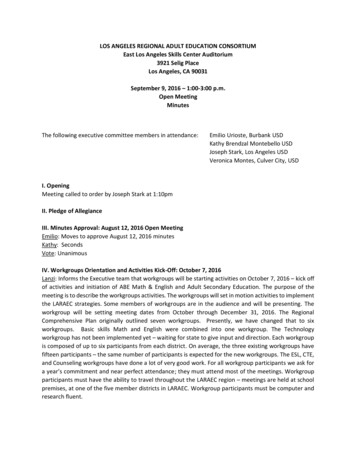
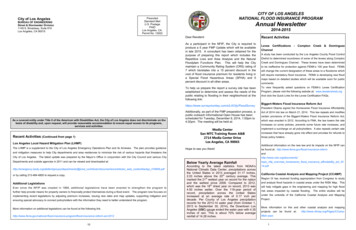
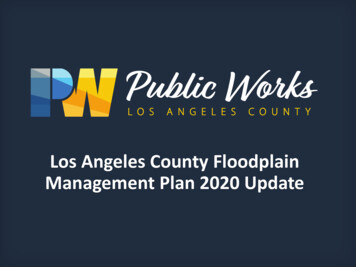
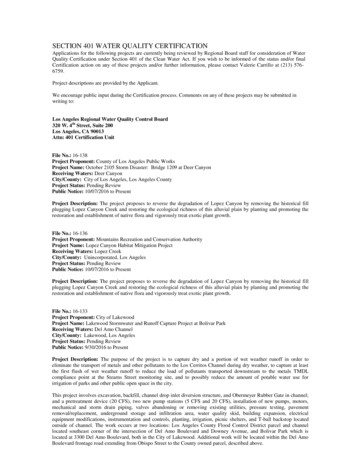

![bTBiesaFn Ep k BIsðèl EdleyIgsmnwgTTYl - calfund [.] org](/img/39/preschool-toolkit-cambodian.jpg)
